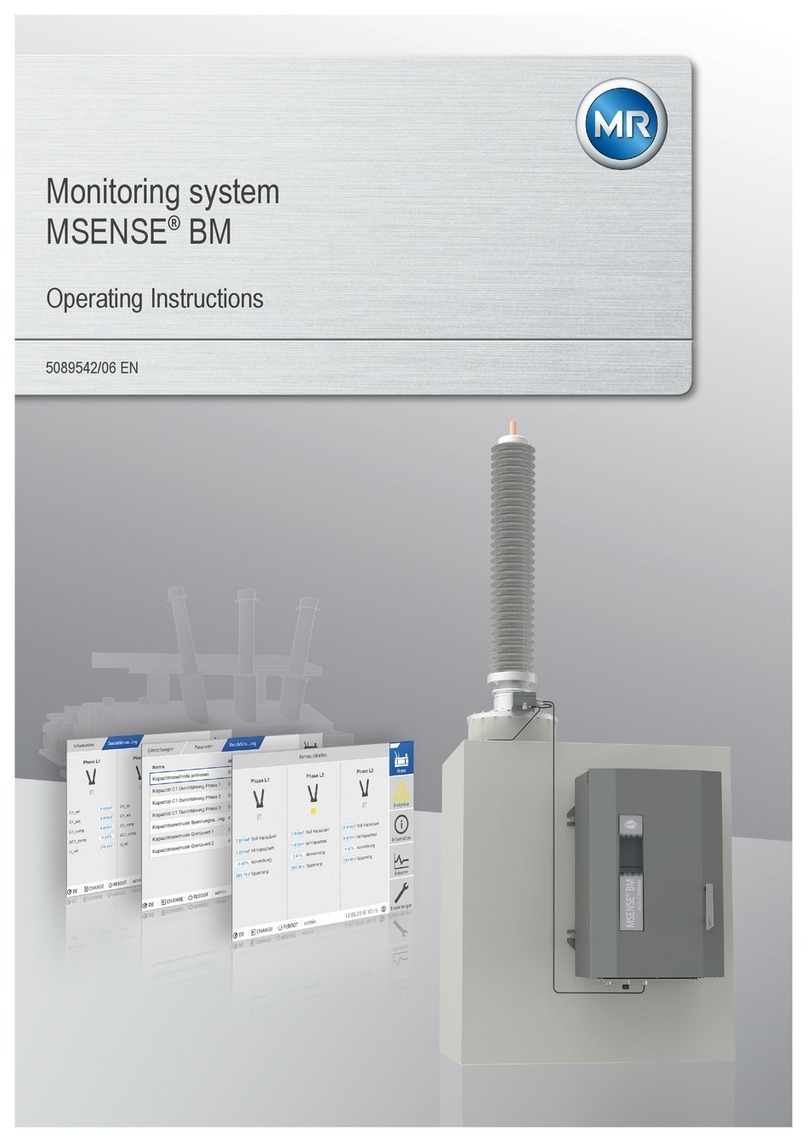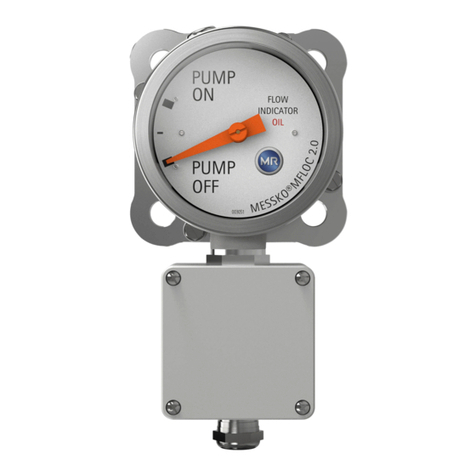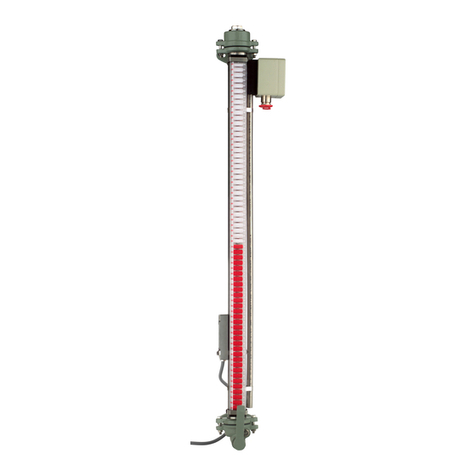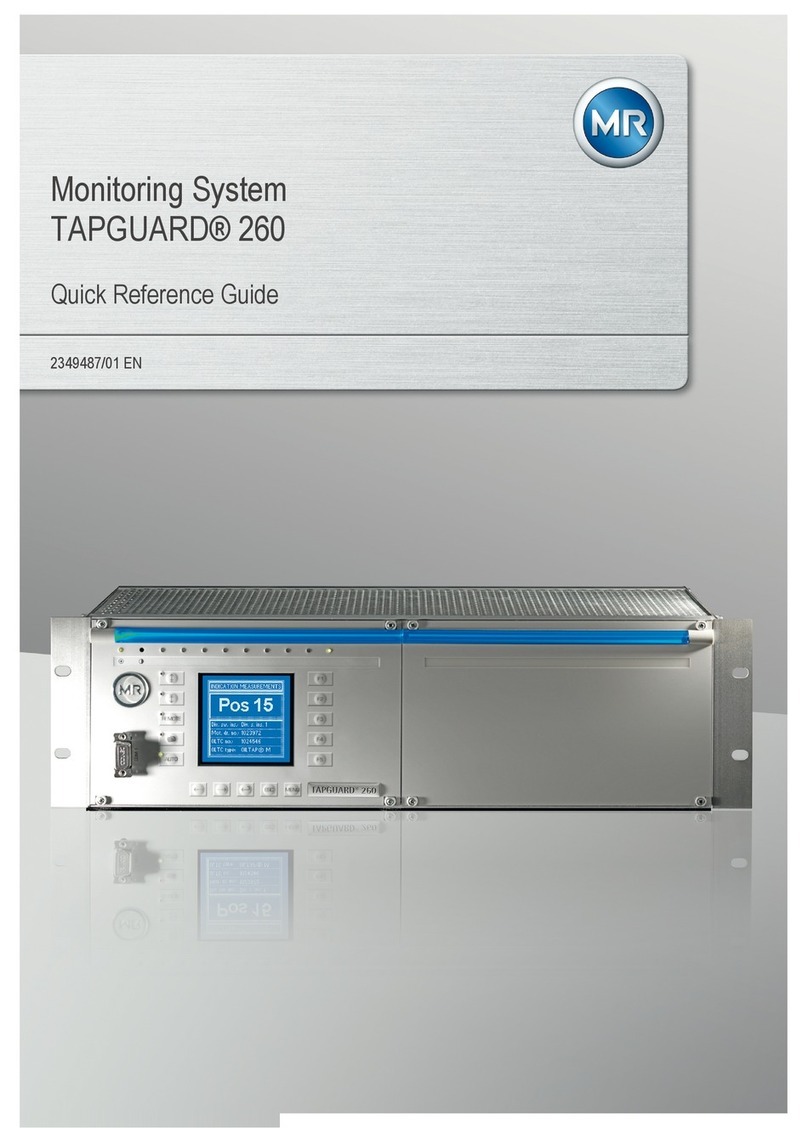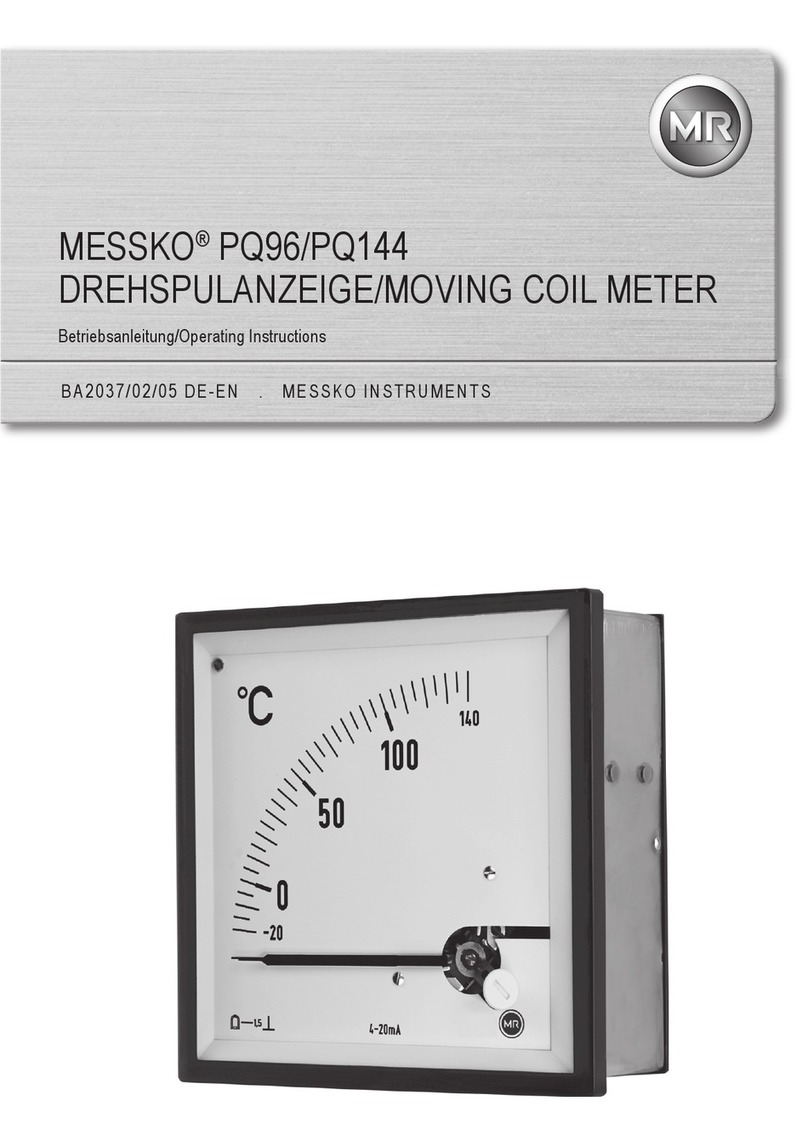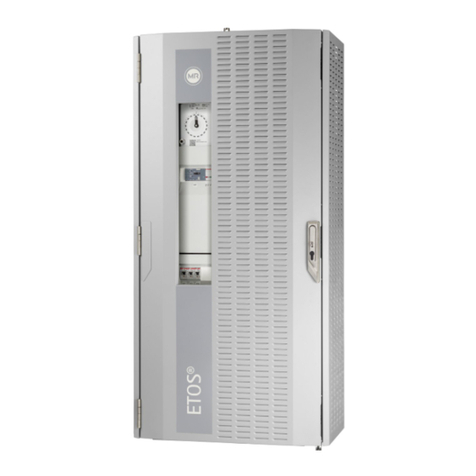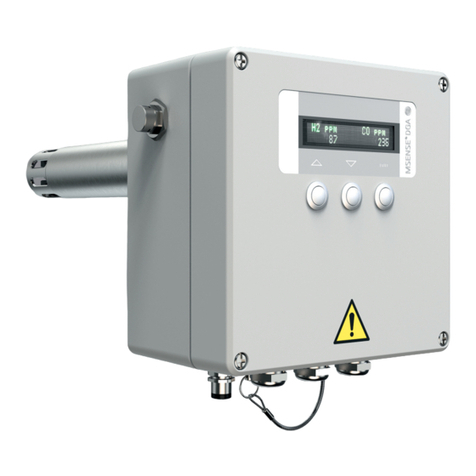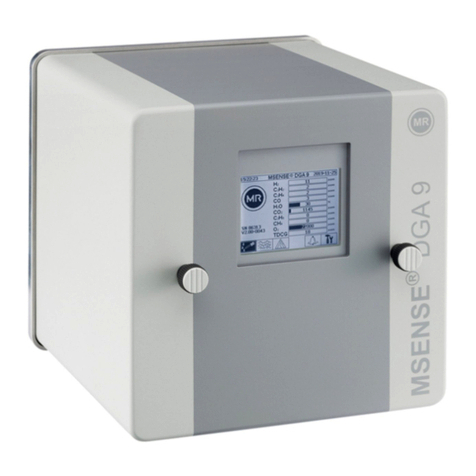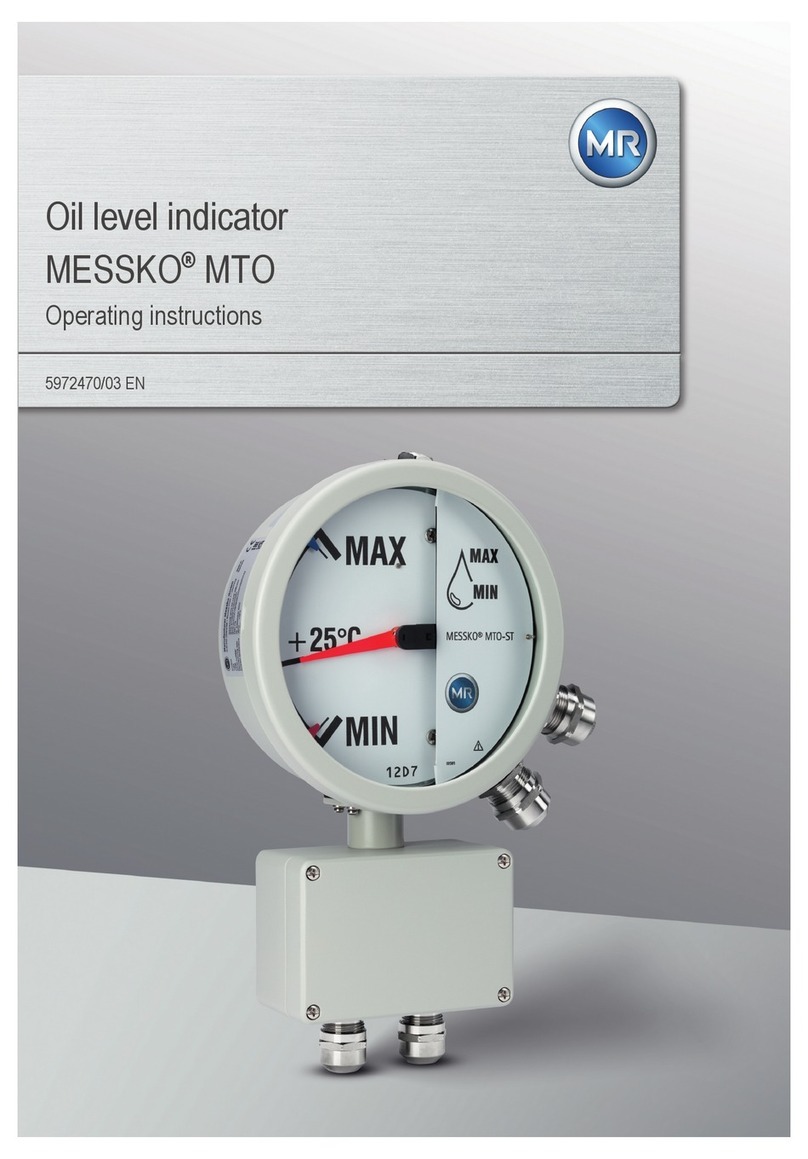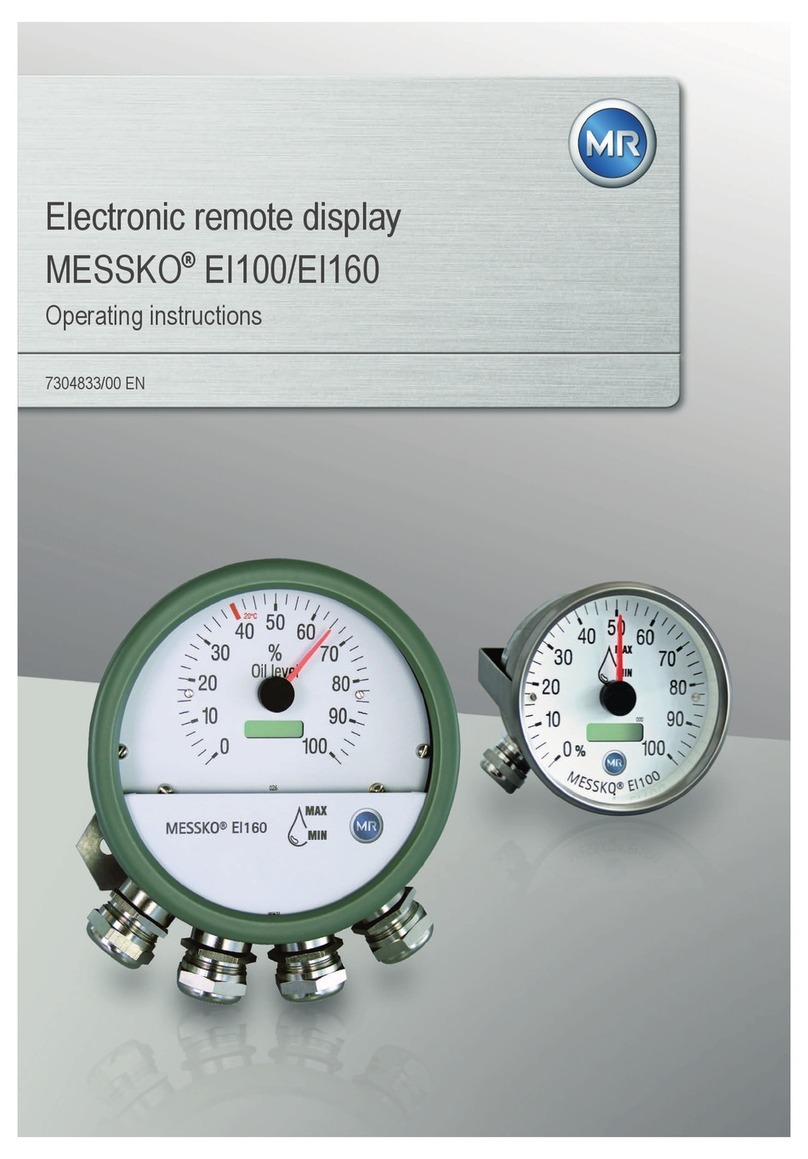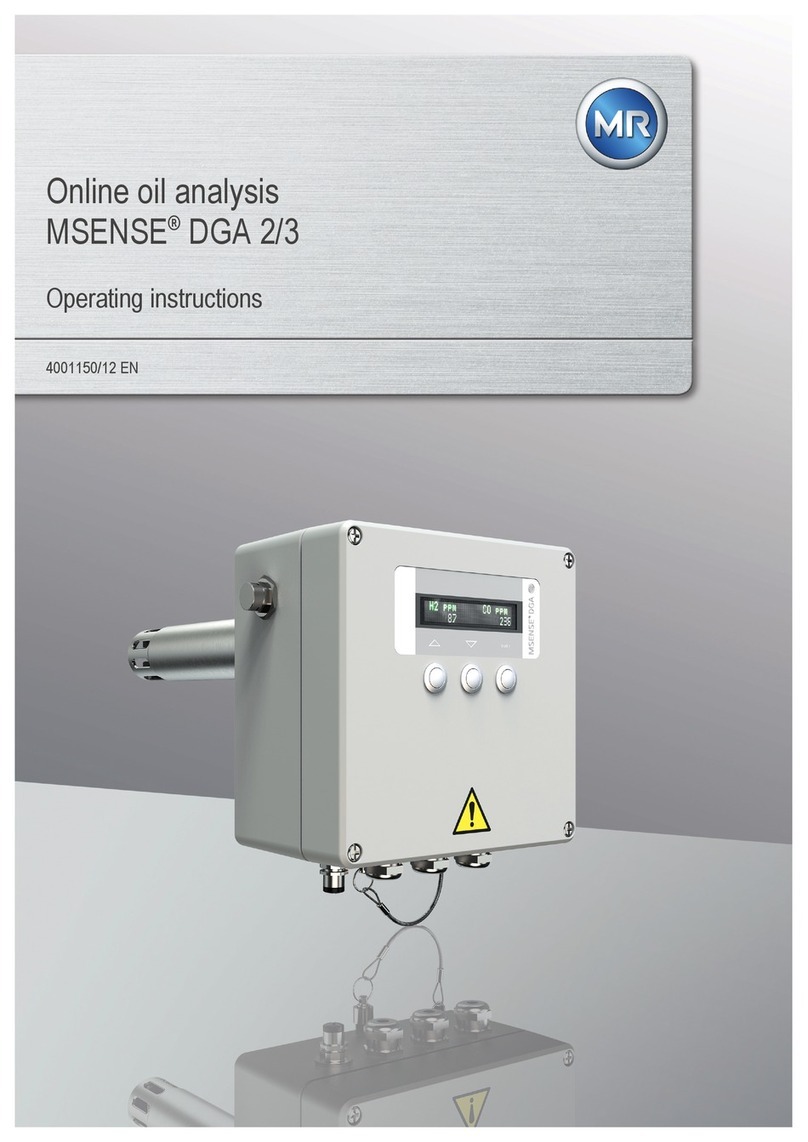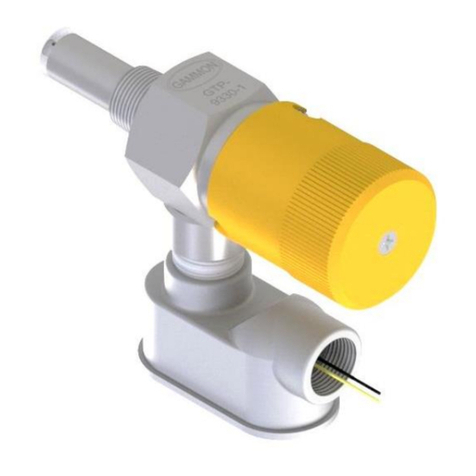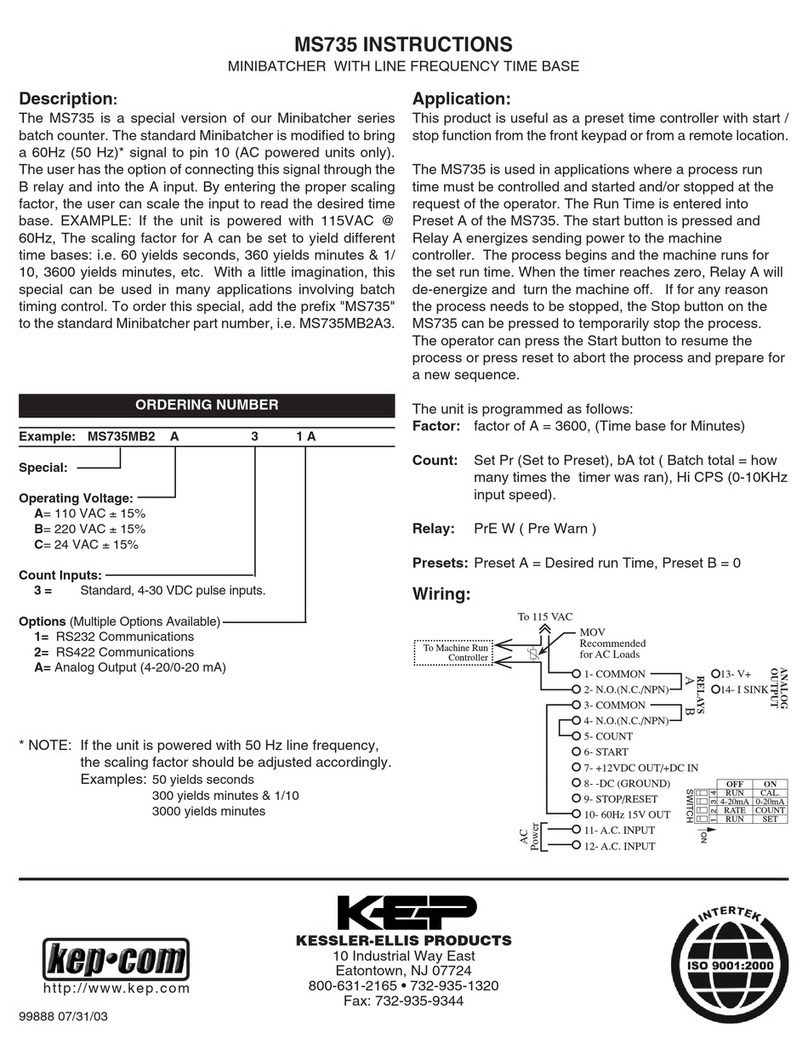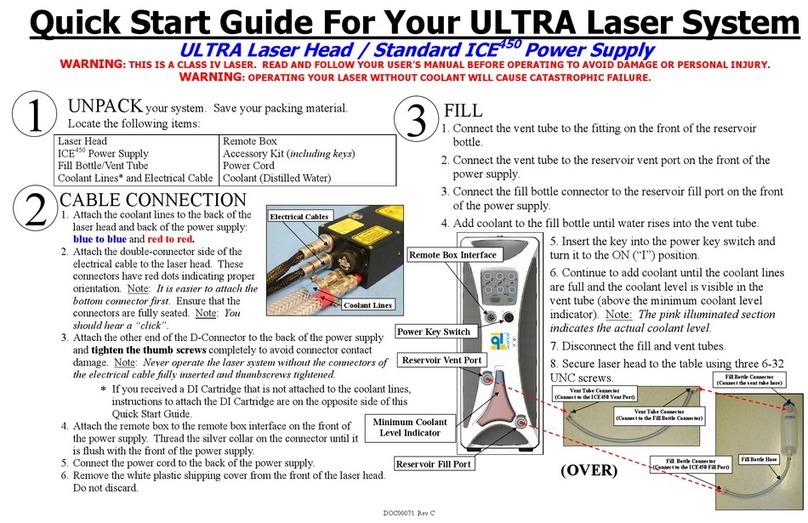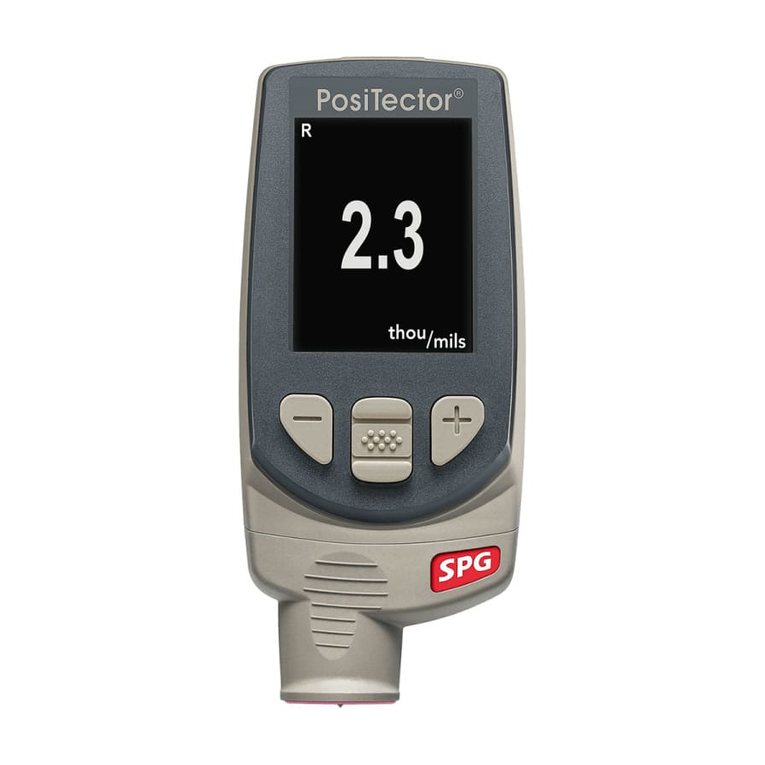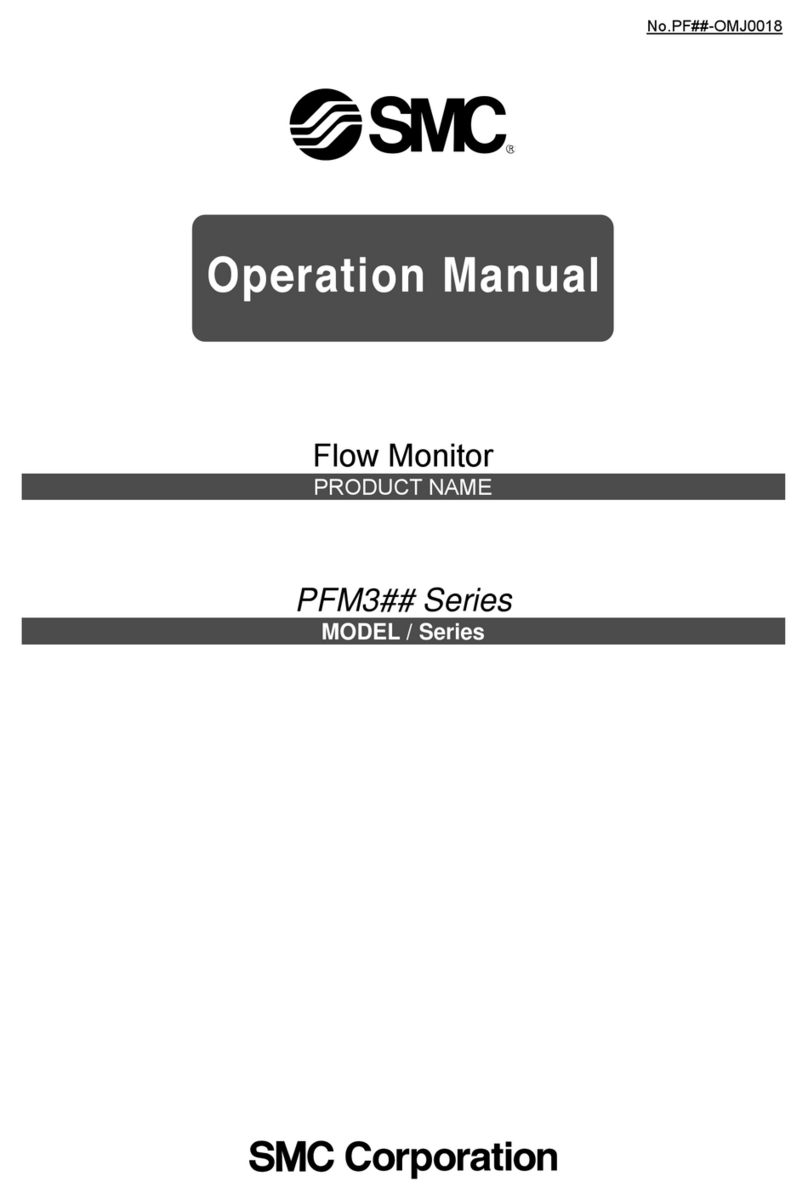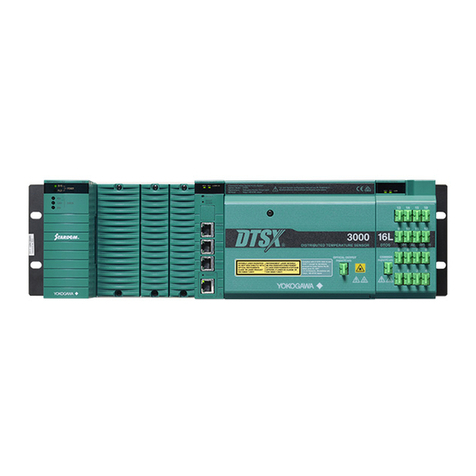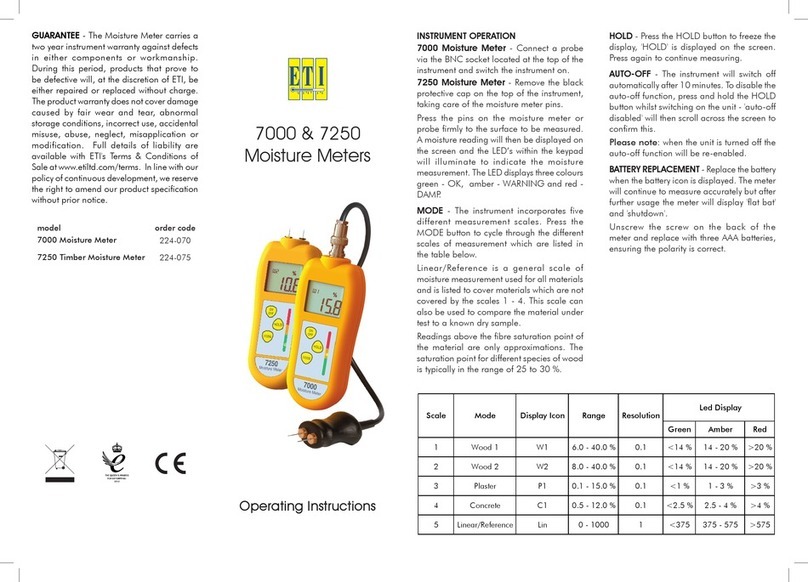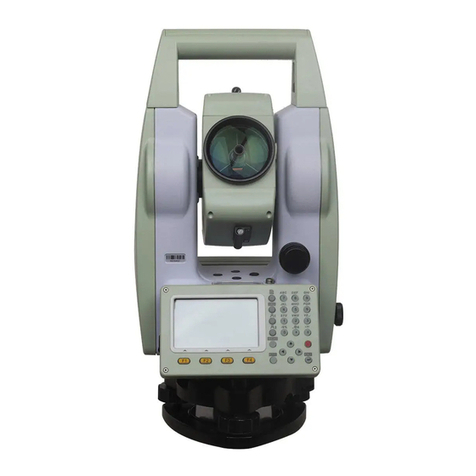MR MESSKO BeTech User manual

BA 3527161/02 EN
MESSKO®BeTech
POINTER THERMOMETER
Operating Instructions

BA 3527161/02 EN2

BA 3527161/02 EN 3
Contents
Please keep this manual for future reference!
NOTE
Data contained herein may differ in details from the
equipment delivered.
We reserve the right to make alterations without
notice.
Contents
1 Safety ................................4
1.1 Safety instructions.......................4
1.2 Intended use ...........................4
1.3 Important notes on equipement operation ....4
2 Productspecication .....................4
2.1 BeTech Oil temperature indicator ...........4
2.2 BeTech Winding temperature indicator .......4
2.3 TT version (option) ......................5
2.4 Pt 100 version (option) ...................5
3 Installation .............................5
3.1 Mounting the device .....................5
3.2 Capilary tube ...........................5
3.3 Pockets ...............................5
3.4 Kick protection..........................5
4 Electrical connection .....................6
4.1 Connecting the microswitches .............6
4.2 Analog output 4 - 20 mA current loop signal ...6
4.3 Analog output 4 - 20 mA current loop signal
and 0 - 5 V DC Voltage output .............7
4.4 Analog output 0 - 5 V DC Voltage output .....8
4.5 Analog output Pt 100 Ohm resistance signal ..9
4.6 Switch settings ........................10
4.7 Switch setting check ....................10
5 Calibration ............................10
5.1 Calibration check.......................10
6 Adjustment of the gradient ...............11
6.1 Adjustment via heating current ............11
6.2 Adjustment via built-in Matching Resistance
MRB110-1 or MRB110-2 .................12
7 Technical data .........................13
8 Appendix .............................14
8.1 Dimensions ...........................14
8.2 Analogue Output / 4 - 20 mA Current Loop
Signal ...............................15
8.3 Analogue Output / 4 - 20 mA Current Loop
Signal and 0 - 5 V DC Voltage output .......16
8.4 Analogue Output / 0 - 5 V DC Voltage output .17
8.5 Analogue Output / Pt100 Ohm restistance
signal................................18
8.6 Wiring diagram / OTI 5 switches and WTI 5
switches and WTI 4 switches + MRB110 ....19
8.7 Connection terminals ...................20
8.8 Dimensions bulb no. 1...................21
8.9 Dimensions bulb no. 2...................21
8.10 Dimensions bulb no. 2F .................21
8.11 Dimensions bulb no. 5...................21
8.12 Dimensions bulb no. 6...................22
8.13 Dimensions bulb no. 8...................22
8.14 Dimensions bulb no. 9...................23
8.15 Dimensions bulb no. 10..................23
8.16 Dimensions bulb no. 27..................23

BA 3527161/02 EN4
1 Safety
1.1 Safety instructions
All personnel involved in installation, commissioning,
operation or maintenance of this equipment must:
- besuitablyqualiedand
- strictly observe these operating instructions.
Improper operation or misuse can lead to
- serious or fatal injury,
- damage to the equipment and other property of the
user
- areductionintheefciencyoftheequipment.
Safety instructions in this manual are presented in three
different forms to emphasize important information.
NOTE
These notes give important information on a certain
issue.
1.2 Intended use
MESSKO®BeTech Oil and Winding temperature
indicators are used to measure temperatures on power
and distribution transformers, reactors or similar equip-
ment.
It is important to read and observe the limit values for
operation indicated on the nameplate and in the operat-
ing instructions prior to commissioning the device.
1.3 Important notes on equipment operation
The user is obliged to comply with the national health
and safety regulations.
It is especially emphasized that works performed to live,
e.g. dangerous-contact components, are permissible
only while these components are either de-energized or
protected against direct contact.
Electrical installation is subject to the relevant national
safety regulations. It is imperative to connect the
ground wire in order to ensure trouble-free operation.
WARNING
This information indicates particular danger to life
and health. Disregarding such a warning can lead
to serious or fatal injury.
CAUTION
This information indicates particular danger to the
equipment or other property of the user. Serious or
fatal injury cannot be excluded.
CAUTION
Installation, electrical connection, commissioning,
and maintenance of the device may only be carried
outbyqualied,skilledpersonnelandonlyinac-
cordance with these operating instructions.
It is the responsibility of the user to make sure that
thedeviceisusedforthespeciedapplicationonly.
For safety reasons, any unauthorized and improp-
erlyexecutedwork,i.e.installation,modication,
alteration of the equipment, electrical connection,
or commissioning of the equipment, are forbidden
withoutrstconsultingMESSKO!
1 Safety
2 Productspecication
2 Productspecication
MESSKO®BeTech Oil and Winding temperature
indicators are used to measure temperatures on power
and distribution transformers, reactors or similar equip-
ment.
They always consist of a temperature sensor which is
connected to the bellow type measuring device with a
capillary tube.
The measuring device is equipped with a pointer which
turns to show the temperature on a scale. The measur-
ing system consisting of sensor, capillary tube. The
measuringdeviceisnonpressurizedandlledwitha
liquid.
2.1 BeTech Oil temperature indicator
Pointerthermometerswithuptoveadjustable
microswitches for indicating the oil temperature. The
indicated temperature is the oil temperature on the sen-
sor of the device. The mechanical measuring system
functions independently and requires no power input.
2.2 BeTech Winding temperature indicator
Pointerthermometerswithuptoveadjustablemicro-
switches for indicating the winding temperature (thermal
image). The temperature rise between cooling liquid
CAUTION
Measuring instruments are sensitive. All parts
should therefore be protected against falling and
against knocks and vibrations.
The capillary tube may not be shortened otherwise
the measuring system will be damaged.

BA 3527161/02 EN 5
3 Installation
(oil) and winding depends on the current in the winding.
The secondary current of the transducer is proportional
to the current in the winding. This transducer feeds a
heating element inside the mechanical thermometer.
That causes an increasing indication (gradient) of the
measured oil temperature according to the transformer
load.
The pointer thermometer with heating element (chapter
6.1) has to be adjusted by setting the heating current.
The type with heating element and built-in matching
resistance MRB110-1 or MRB110-2 (chapter 6.2) has to
be adjusted by setting the resistor.
2.3 TT version (option)
These devices are additionally equipped with a sensor
which converts the temperature value into an electrical
signal (4 to 20 mA and/or 0 to 5 V DC). The sensor
requires a power supply (24 V DC).
2.4 Pt100 version (option)
In this device the simulated Pt100 Ohm resistance out-
put is linear and proportional to the indicated tempera-
ture on the instrument dial.
3 Installation
3.1 Mounting the device
Anti-vibration mountings are included in the delivery
and must be used to prevent mechanical wear of the
instruments.
3.2 Capillary tube (Fig. 1/8)
Never carry the thermometer by the capillary tube. Do not
twist or bend it too sharply. The minimal bending radius is
25 mm. Clamp the capillary at approx. 400 mm intervals.
Any excess capillary should be wound into a spiral with
diameter of minimum 200 mm.
3.3 Pockets
Oillledpocketsshouldnotbeover-lled–leave15%
space for thermal expansion of the oil, once the bulb is
inserted into the pocket. Make sure the gasket or seal is
appropriate.
3.4 Kick protection
For safety reasons the bulbs are provided with a built-in
kick protection.
CAUTION
The operating and installation conditions demanded
by this installation and operating instructions must
be strictly complied with.
Fig. 1
Fig. 2
kick protection
example bulb no. 5
MESS KO®
BeTe ch
min. Ø 200 mm
Wicklungstemperatur
Winding temperature
Température de l’enroulement
Temperatura del devanado
Temperature do enrolamento
Temperatura avvolgimento
Sarğı Sıcaklığı
Температураобмотки
绕组温度计
Lindningstemperatur
1
2
3
4
5
6
1
7
8
1
1
9

BA 3527161/02 EN6
4 Electrical connection
4 Electrical connection
4.1 Connecting the microswitches
To connect the microswitches open the housing via the
four screws of the housingh cover (Fig. 1/2). Remove
the outer sheaths of the connecting cables to a length
of approx. 160 mm and then the insulation of the indi-
vidual conductors to a length of approx. 6 mm. Install
the cable glands provided loosely to the incoming
cables and housing.
Pay close attention to cable gland assembly and
ensurethatthesealisproperlyttedtoavoidanywater
ingress. Connect the incoming wiring to the terminal
strip (Appendix, chap. 8.7) in accordance with the con-
nection diagram (Appendix, chapter 8.2 - 8.6).
4.2 Analog output 4 - 20 mA current loop signal
(see also chapter 8.2 for installation examples)
This analogue output is an optional feature to the
MESSKO®BeTech Oil and Winding Temperature
Indicators. The output is linear and proportional to the
indicated temperature on the instrument dial, where
4 mA is provided at the lowest value on the dial and
20 mA at the highest value, for instance 4 mA at 0 °C
and 20 mA at 150 °C (see graph).
The output can be used for several purposes such
as connection to a computer, to a SCADA system or
for remote monitoring by Remote Analogue or Digital
Indicators. Because of the high load allowed, the same
output can be used for more than one purpose at the
same time.
Since the output is provided from the indication,
the same temperature is displayed both locally and
remotely - no differences because of settings etc as if
separate transmitters are used.
The electrical wiring is easily connected to the terminal
board inside the OTI or WTI (see appendix, chapter
8.2).
CAUTION
The terminals 61, 62 and 63 must be short-circuited
during insulation test. The test voltage must be rai-
sed gradually. Remove the clamps on the terminal
boardoncethetestsarenished.
WARNING
Electrical voltages, danger to life!
All connecting wiring must be free of voltage before
opening the device.
CAUTION
When closing the housing tighten the srews with a
torque of max. 1 Nm.
Fig. 3

BA 3527161/02 EN 7
A separate shielded cable is recommended for the wir-
ing to the 4 - 20 mA analogue output. This includes the
Supply Voltage and the mA output signal (= terminals
61, 62 and 63). No other signals should be wired
through the same cable and make sure the shield is
connected to ground on one side only.
4.3 Analog output 4 - 20 mA current loop signal
and 0 - 5 V DC Voltage output (see also chapter 8.3
for installation examples)
This analogue output is an optional feature to the
MESSKO®BeTech Oil and Winding Temperature Indi-
cators. There are two outputs provided, both are linear
and proportional to the indicated temperature on the
instrument dial, where 4 mA and 0 V DC is provided at
the lowest value on the dial and 20 mA and 5 V DC at
the highest value (see graph).
The outputs can be used for several purposes such as
connection to a computer, to a SCADA system or for
remote monitoring by Remote Analogue or Digital Indi-
cators. A common installation is to use the mA signal for
remote monitoring and the V DC output for a SCADA or
computer connection.
Since the outputs are provided from the indication,
the same temperature is displayed both locally and
remotely - no differences because of settings etc as if
separate transmitters are used.
The electrical wiring is easily connected to the terminal
board inside the OTI or WTI (see appendix, chapter 8.3).
A separate shielded cable is recommended for the
wiring to this analogue output. This includes the Supply
Voltage and the mA and V DC output signals (= ter-
minals 61, 62, 63 and 64). No other signals should be
wired through the same cable and make sure the shield
is connected to ground on one side only.
If only the Voltage output is to be used, the mA output
must remain short circuited. Please leave the clamp in
place on terminals 61 and 62.
CAUTION
The terminals 61, 62, 63 and 64 must be short-
circuited during insulation test. The test voltage
must be raised gradually. Remove the clamps on
theterminalboardoncethetestsarenished.
Fig. 4

BA 3527161/02 EN8
4.4 Analog output 0 - 5 V DC Voltage output
(see also chapter 8.4 for installation examples)
This analogue output is an optional feature to the
MESSKO®BeTech Oil and Winding Temperature
Indicators. The output is linear and proportional to the
indicated temperature on the instrument dial, where 0
V DC is provided at the lowest value on the dial and 5
V DC at the highest value, for instance 0 V DC at 0 °C
and 5 V DC at 150 °C (see graph/Fig. 5).
The output can be used for several purposes such as
connection to a computer, to a SCADA system or per-
haps for remote monitoring. Commonly the V DC output
is used for a SCADA or computer connection.
Since the outputs are provided from the indication,
the same temperature is displayed both locally and
remotely - no differences because of settings etc as if
separate transmitters are used.
The electrical wiring is easily connected to the terminal
board inside the OTI or WTI (see appendix, chapter
8.4).
A separate shielded cable is recommended for the
wiring this analogue output. This includes the Supply
Voltage and the V DC output signal (= terminals 61, 63
and 64). No other signals should be wired through the
same cable and make sure the shield is connected to
ground on one side only.
CAUTION
The terminals 61, 63 and 64 must be short-circuited
during insulation test. The test voltage must be rai-
sed gradually. Remove the clamps on the terminal
boardoncethetestsarenished.

BA 3527161/02 EN 9
4.5 Analog output Pt100 Ohm resistance signal
(see also chapter 8.5 for installation examples)
This analogue output is an optional feature to the
MESSKO®BeTech Oil and Winding Temperature
Indicators. The simulated Pt100 Ohm resistance output
is linear and proportional to the indicated temperature
on the instrument dial. For typical resistance values -
please see graph and table.
The output can be used for several purposes such as
connection to a computer, to a SCADA system or for
remote monitoring. This output is provided with a 3-wire
connection as standard, to facilitate compensation for
wire resistance etc. Often the output is connected to the
Signal Transducer Pt-MU for transmission over longer
distances.
Since the output is provided from the indication,
the same temperature is displayed both locally and
remotely - no differences because of settings etc. as if
separate transmitters are used.
The electrical wiring is easily connected to the terminal
board inside the OTI or WTI - (see appendix, chapter
8.5).
A separate shielded cable is recommended for the
wiring to this analogue output. This includes all the
terminals 61, 62 and 63. No other signals should be
wired through the same cable and make sure the shield
is connected to ground on one side only.
Temperature [° C] Resistance Value [Ohm]
0 100.00
25 109.73
50 119.40
100 138.50
150 157.31
CAUTION
The terminals 61, 62 and 63 must be short-circuited
during insulation test. The test voltage must be rai-
sed gradually. Remove the clamps on the terminal
boardoncethetestsarenished.

BA 3527161/02 EN10
5 Calibration
4.6 Switch settings
The switches are individually adjustable and can be set
to any temperature on the individual scale, regardless
of other switch settings. The setting is done in the fol-
lowing steps:
a. Loosen the set screw on the orange pointer
b. Rotate the drum while holding the set screw in
position until the orange pointer points at the desired
temperature setting on the scale.
c. Tighten the set screw in this position.
d. Check the switch setting as per below.
4.7 Switch setting check
Keep the instrument in vertical position and turn the
shaft with the drums towards higher temperatures
(check that the pointer for the indication moves this
way) and check that contact is obtained at the desired
value. If necessary please re-adjust the setting.
5 Calibration
Every instrument is factory calibrated so no additional
calibration is necessary. This applies for all functions,
including Indication, Switches and Analogue Output if
applicable.
5.1 Calibration check
Put the bulb (completely) in boiling water and check the
reading after 15 minutes. If the error is larger than the
stated tolerance (like ±3 °C) please contact your local
representative or the manufacturer. As an alternative to
boiling water a well-stirred (oil) bath of min 5 l volume
with control thermometer or the MESSKO®Calibration
Bath can be used.
CAUTION
Do not turn the shaft of the drums in the other direc-
tion, since calibration may change.

BA 3527161/02 EN 11
6 Adjustment of the gradient
6 Adjustment of the gradient for Winding
Temperature Indicator WTI
6.1 Adjustment via heating current
A) Gradient
The gradient is the temperature rise above oil tempe-
rature for the Winding Temperature Indicator, WTI. The
WTI is showing a Thermal Image of the transformer
winding temperature.
B) Calculation
You can use the graphs or the table to get the gradient -
or calculate the temperature rise as:
G = K x Ih
2
where G = the gradient (°C)
Ih= the heating current (A)
K = a constant which is depending on the
bulb type.
C) Technical data
Max heating current, Ih= 2.3 A continously
Max heating current, Ih= 10 A for 5 seconds
Thermal time constant: 9 minutes
The gradients are shown for oil temperature 60°C
D)Verication
To verify the gradient (temperature rise), please:
- Keep the sensing bulb at a constant temperature
during the test, preferrably in an oil or water bath
- Feed a stable current (AC or DC) to the WTI heating
element, corresponding to the required temperature rise
- Keep the instrument cover mounted on the instrument
- Wait 45 minutes before checking the temperature
indication
-Thedifferencebetweenthenaltemperatureandthe
temperature of the bath is the gradient
0
10
20
30
40
50
60
0,55
0,50
0,60
0,65
0,70
0,75
0,80
0,85
0,90
0,95
1,00
1,05
1,10
1,15
1,20
1,25
1,30
1,35
1,40
1,45
1,50
Gradient °C (or K)
Nominal
Heating Current Ihin A (Ampere)
Min tol.
Max tol.
Fig. 7 *)
Constant K
Measuring ranges
Bulb types A: 0 to 150 °C
C: -20 to +130 °C
E: 0 to 160 °C G: -40 to 160 °C
1, 2, 2F, 5, 8, 22, 27 22 23.5 29
6 24.5 26 32.5
9, 10 24 25.5 32
*) only valid for bulb types 1, 2, 2F, 5, 8, 22, 27 and measuring ranges A (0 to 150 °C) and C (-20 to +130 °C)

BA 3527161/02 EN12
6.2 Adjustment via built-in Matching Resistance
MRB110-1 or MRB110-2
A) Determine the required gradient in °C (or K) (from
the heat-run tests).
B)Checkthecurrent(inAmps)fromtheCTat100%
load.
C) Follow the line for the CT current to where the
gradient on the x-axis cuts the line.
D) Check the resistance value (in Ohms) on the y-axis
for this point. This is the total resistance value over
terminals5–5(meaningtheresistanceofthehea-
ting element in parallel with the matching resistance)
(refer to chapter 8.6, Figure 14).
E)ConnectanOhm-metertoterminals5–5andadjust
the Matching Resistance MRB110-1 or MRB110-2
until the determined resistance value is reached.
Secure the lock-nut to this value.
F) With this setting you should reach the required
gradientforthe100%CTcurrentyouhavechosen.
G) To verify the setting, please feed a stable current
(ACorDC)equivalenttothe100%CTcurrentto
theterminals5–5,keeptheinstrumentcoveron
the instrument and wait 45 minutes before verifying
the reading and the achieved temperature gradient.
If adjustments of the gradient are necessary please
adjust:
a. towards a higher resistance value to get a higher
gradient
b. towards a lower resistance value to get a lower
gradient
H) For more details please also refer to chapter 6.1.
Fig. 8 Temperature gradient graph for bulb types 1, 2, 2F, 5, 8, 22, 27 and measuring ranges
0...150 °C and -20...130 °C

BA 3527161/02 EN 13
7 Technical data
Dimensions Refer to chap. 8.1
Materials
Housing: Die casted aluminium,
polyester powder coated,
RAL 7033
Viewing glass: Laminated safety glass
(standard); UV stabilized
polycarbonate (optional)
Capillarytube: Squareange4holes;
G3/4“; G1“; 7/8“-14UNF;
other thread joints on
request
Cable glands: Up to 3 x M20 x 1.5
and 1 x M16 for analogue
output
Specications
Measuring ranges: 0...150 °C or
-20...130 °C or
0...160 °C or
-40...160 °C;
other ranges on request
Indication accuracy: ± 3 °C (30-150 °C)
(optional: ± 2 °C or 1.5 °C)
Place of installation: Indoors and outdoors,
tropical and arctic climate
Ambient temperature: -40 ... +70 °C
(optional: polar execution
down to -60 °C)
Insulation voltage: 2.5 kV 50 Hz 1 min
Protection class: IP 55 in accordance with
IEC 60 529;
(optional: IP 65)
Analog output: 4-20 mA; 4-20 mA and
5 V DC; 5 V DC; Pt100
Weight: Approx. 4 kg
Microswitches
Number: 2, 3, 4 or 5
Switch rating: Standard SPDT 250 V AC /
15 A;
(optional:
MBO SPDT 250 V AC/10 A
or 250 V DC / 5 A,
DPDT or gold plated SPDT)
Switch hysteresis: 12 °C ± 2 °C; others on
request
7 Technical data

BA 3527161/02 EN14
8 Appendix
8.1 Dimensions
190
7.48"
100
3.94"
56
2.20"
100
3.92" 282
11.10"
194
7.65"
121
4.74"
M6x16
80
3.15" 100
3.94"
18,8
.74"
Ø
79,5
3.13"
Wicklungstemperatur
Winding temperature
Température de l’enroulement
Temperatura del devanado
Temperature do enrolamento
Temperatura avvolgimento
Sarğı Sıcaklığı
Температура обмотки
绕组温度计
Lindningstemperatur
MESSKO®
BeTech
Fig. 9

BA 3527161/02 EN 15
8.2 Analogue Output / 4 - 20 mA Current Loop Signal (optional)
Fig. 10
MESSKO®
BeTech
61 62
RIA130-1
D1272AT
+ –
SNT36
+ –
AC / DC
4-20 mA
AC, D1272AT only
63
24 V DC
-V mA +V
MESSKO®
BeTech
61 62
RIA130-1
D1272AT
+ –
SNT36
+ –
AC / DC
4-20 mA
AC, D1272AT only
63
24 V DC
-V mA +V
MESSKO®
BeTech
61 62
RIA130-1
D1272AT
+ –
SNT36
+ –
AC / DC
4-20 mA
AC, D1272AT only
63
24 V DC
-V mA +V
SCADA or
computer
+ –
Installation Example A:
Installation Example B:
(SNT36 next to OTI/WTI
and remote indicator
further away)
Installation Example C:
(several loads in series)
Abbreviations:
SNT36 = Power Supply Unit
RIA = Remote Indicator Analogue
D1272AT = Remote Indicator Digital
For more details on these products
please refer to separate operating
instructions.

BA 3527161/02 EN16
8.3 Analogue Output / 4 - 20 mA Current Loop Signal and 0 - 5 V DC Voltage output (optional)
Fig. 11
Installation Example A:
Installation Example B:
(SNT36 next to OTI/WTI and remote indicator and SCADA/computer
further away)
MESSKO®
BeTech
61 62 64
SCADA or
computer
+ –
RIA130-1
D1272AT
+ –
SNT36
+ –
AC / DC
4-20 mA
AC, D1272AT only
63
24 V DC
-V mA +V V out
V DC out
MESSKO®
BeTech
61 62 64
SCADA or
computer
+ –
RIA130-1
D1272AT
+ –
SNT36
+ –
AC / DC
4-20 mA
AC, D1272AT only
63
24 V DC
-V mA +V V out
V DC out
Abbreviations:
SNT36 = Power Supply Unit
RIA = Remote Indicator Analogue
D1272AT = Remote Indicator Digital
For more details on these products please refer to separate operating instructions.

BA 3527161/02 EN 17
8.4 Analogue Output / 0 - 5 V DC Voltage output (optional)
Fig. 12
MESSKO®
BeTech
–V
61
+V
63
V out
64
V DC out
SCADA or
computer
+ –
SNT36
+ –
AC / DC
24 V DC
MESSKO®
BeTech
–V
61
+V
63
V out
64
V DC out
SCADA or
computer
+ –
SNT36
+ –
AC / DC
24 V DC
Abbreviations:
SNT36 = Power Supply Unit
For more details on this product please refer to separate operating instructions.
Installation Example A:
Installation Example B:
(SNT36 next to OTI/WTI and SCADA/computer further away)

BA 3527161/02 EN18
8.5 Analogue Output / Pt100 Ohm restistance signal (optional)
Doc no. TS 14 Date. 2013-01-25 Rev. Page: 2 (2)
11 12 14 21 22 24 31 32 34 41 42 44 61 62 63 64
C NC NO C NC NO C NC NO C NC NO
Pt 100
5 5 11 12 14 21 22 24 31 32 34 41 42 44 61 62 63 64
C NC NO C NC NO C NC NO C NC NO
Heang element
Match. res. MRB
Pt 100
Installation Example:
Wiring Diagram Example: OTI with 4 switches + Pt100
Wiring Diagram Example: WTI with 4 switches and MRB110 + Pt100
RIA130-1
or
D1272AT
Pt-MU
61 62 63
Pt 100
Pt 100
4-20 mA
AC/DC
AC, D1272AT only
+
-
MESSKO®
BeTech/Bellow Technology
TS 14
Analogue Output
Pt 100 Ohm resistance signal
Messko GmbH
Gewerbegebiet An den Drei Hasen
Messko-Platz 1
61440 Oberursel
Germany
Phone: +49 (0)6171 6398-0
Fax: +49 (0)6171 6398-98
Web: www.messko.com
Fig. 13
Abbreviations:
RIA = Remote Indicator Analogue
D1272AT = Remote Indicator Digital
Pt-MU = Signal Transducer
MRB = Matching resistance
MESSKO®
BeTech
61 62 63
Pt 100
Pt-MU RIA130-1
or
D1272AT
AC / DC
4-20 mA
AC, D1272AT only
Pt 100
+
–
Installation Example:

BA 3527161/02 EN 19
8.6 Wiring diagram / OTI 5 switches and WTI 5 switches and WTI 4 switches + MRB110 (optional)
Doc no.
TS 40
Date.
2013-01-25
Rev. A Page: 1 (1)
11 12 14 21 22 24 31 32 34 41 42 44
C NC NO C NC NO C NC NO C NC NO
OTI with 5 switches
5 5 11 12 14 21 22 24 31 32 34 41 42 44
C NC NO C NC NO C NC NO C NC NO
Heang element
Match. res. MRB
WTI with 4 switches and MRB110
WTI with 5 switches
5 5 11 12 14 21 22 24 31 32 34 41 42 44
C NC NO C NC NO C NC NO C NC NO
Heang element
Messko GmbH
Gewerbegebiet An den Drei Hasen
Messko-Platz 1
61440 Oberursel
Germany
Phone: +49 (0)6171 6398-0
Fax: +49 (0)6171 6398-98
Web: www.messko.com
MESSKO®
BeTech/Bellow Technology
Wiring diagram
OTI 4 switch and
WTI 4 switch and
WTI 4 switch + MRB110
51 52 54
C NC NO
51 52 54
C NC NO
Fig. 14

BA 3527161/02 EN20
B
MES SKO ®
BeTech
8.7 Connection terminals
Fig. 15
Matching resistance
Other manuals for MESSKO BeTech
1
Table of contents
Other MR Measuring Instrument manuals
Popular Measuring Instrument manuals by other brands
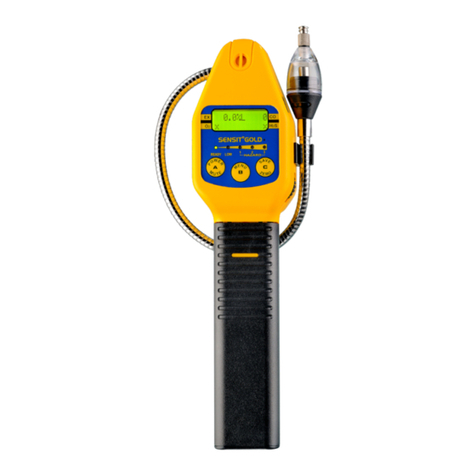
SENSIT Technologies
SENSIT Technologies GOLD CGI instruction manual
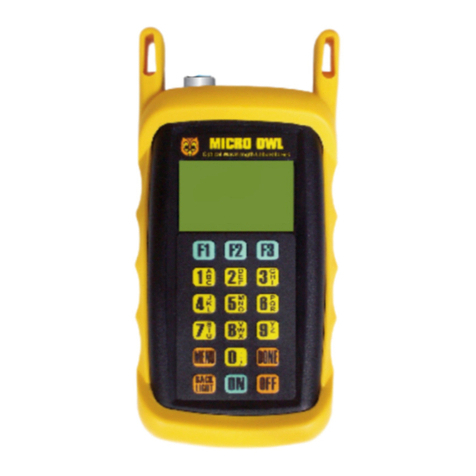
OWL
OWL Micro OWL 2 Series Testing
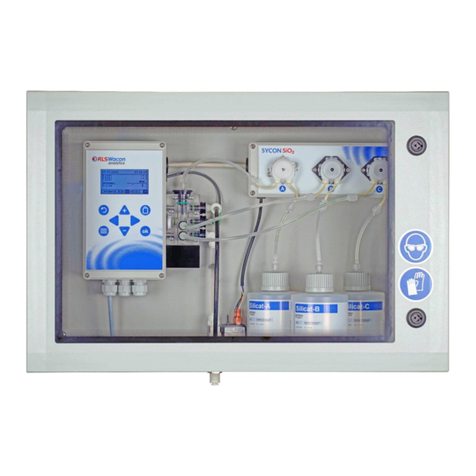
RLS Wacon
RLS Wacon SYCON Silicate operating manual

Circutor
Circutor CEM-C31-T1 instruction manual
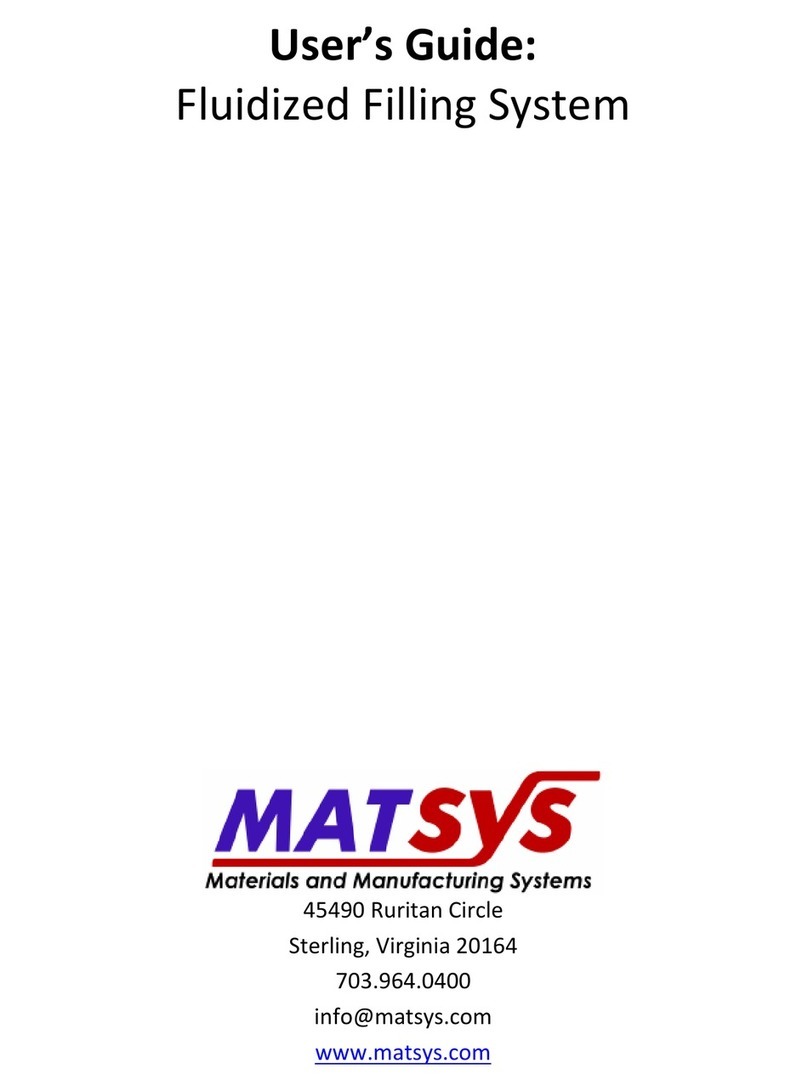
MATSYS
MATSYS Fluidized Filling System user guide
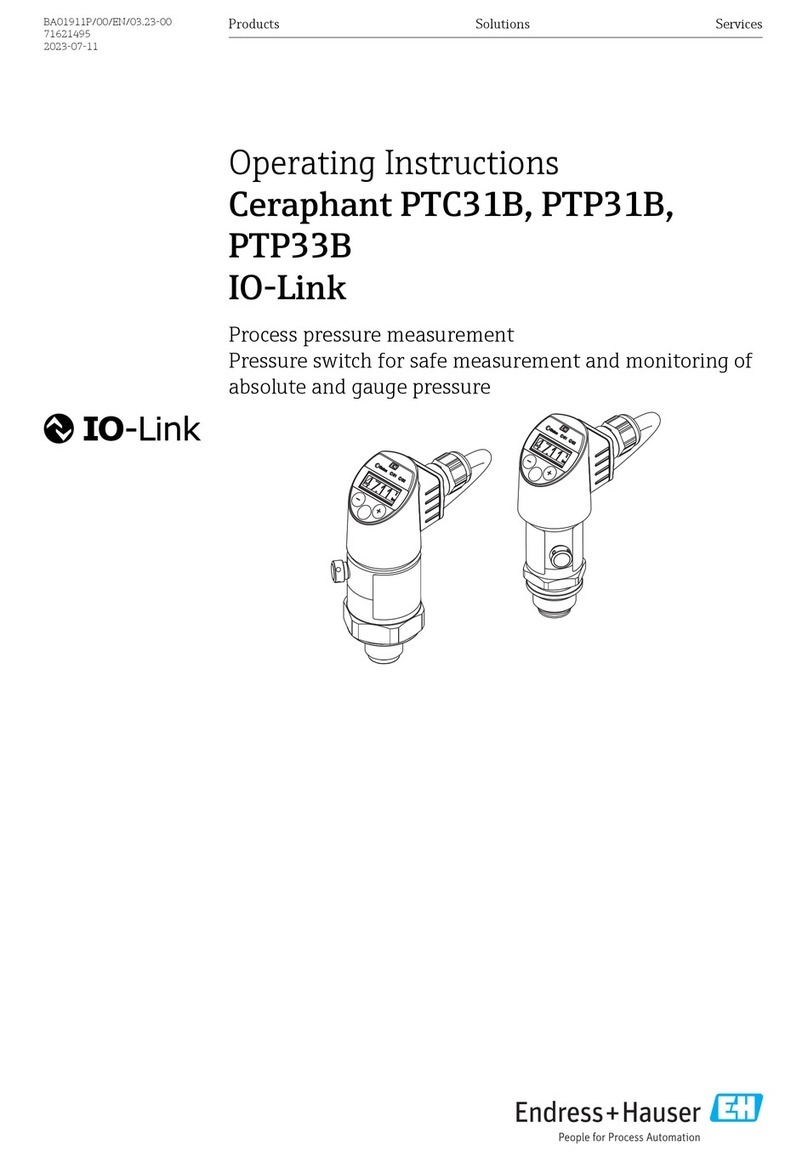
Endress+Hauser
Endress+Hauser IO-Link Ceraphant PTC31B operating instructions
